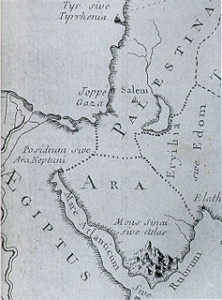Jaime Manuschevich
Israel
Israel and the Sinai Peninsula are promoted(a) as the location of Atlantis by Jaime Manuschevich. His contention is based on what he claims were the different geographical perceptions of the Egyptians and Greeks that led to Plato misinterpreting Solon’s notes and erroneously placing Atlantis in the Atlantic Ocean. He presented his radical views at the 2005 Atlantis Conference.
On his website, Manuchevich outlines the reasoning behind his theory(b) in a series of blogs. He also offers further insights in an old Atlantis Rising forum(c).
More tangible but no more credible is the site of Atlit-Yam of the coast of Israel, which the media insist on referring to as “Israel’s Atlantis”. Atlit-Yam is one of six “marvelously preserved” prehistoric settlements running along the Israeli coastline from Haifa to Atlit that were submerged roughly 7,000 years ago(e).
Ryan Pitterson, the author of Judgement of the Nephilim [1620], contends that Atlantis was situated on the Golan Heights, overlooking the Sea of Galilee and currently occupied by Israel. The region is home to Gilgal Refaim, an archaeological site consisting of several concentric stone walls with demonstrable astronomical alignments. In a US promotional radio interview, the subject of Atlantis was touched on by Pitterson and was later highlighted by the UK’s Express newspaper with the hackneyed ‘Atlantis Found?’ headline(d).
Between the 16th and the 19th centuries a number of commentators added a theological element to the search for Atlantis by identifying it with the Holy Land.
(a) http://self.gutenberg.org/articles/Location_hypotheses_of_Atlantis (link broken)
(b) Background on Why Israel Was Atlantis (II) | Atlantis is Israel (wordpress.com)
(c) Atlantis Rising: Atlantis in Israel (archive.org)
(e) https://www.timesofisrael.com/remains-of-neolithic-atlantis-found-off-haifa-coast/ *
Manuschevich, Jaime *
Jaime Manuschevich of the University of Chile has recently (2002) produced a book in Spanish[468] that places Atlantis in what is now Israel and the Sinai Peninsula. The most dramatic part of his thesis is that at the time, 9500 BC, this region was in fact an island  bounded on the west by a waterway roughly following the course of today’s Suez Canal and on the east by a widened Dead Sea and Jordan River with a northern outlet to the Mediterranean. Manuschevich claims that instead of thinking in terms of Atlantis sinking into the sea we should consider the possibility that the sea sank separating the Dead Sea, the Mediterranean and the Red Sea resulting in earlier waterways becoming impassable to voyagers. To support his theory Manuschevich cites geological and historical evidence.
bounded on the west by a waterway roughly following the course of today’s Suez Canal and on the east by a widened Dead Sea and Jordan River with a northern outlet to the Mediterranean. Manuschevich claims that instead of thinking in terms of Atlantis sinking into the sea we should consider the possibility that the sea sank separating the Dead Sea, the Mediterranean and the Red Sea resulting in earlier waterways becoming impassable to voyagers. To support his theory Manuschevich cites geological and historical evidence.
He bases his views on the generally accepted fact that the earliest civilisations were to be found in the Middle East. Manuschevich wrote a paper, outlining what he perceives are geographical errors contained in Plato’s tale, for presentation to the Melos Atlantis Conference in 2005(a).
A Q & A session from 2005 is also worth a read(c).
In 2006, he engaged in lengthy exchanges with Johann Saltzman in a forum on the now defunct Atlantis Rising website(b). Further ‘Atlantis in Israel’ debates took place on the AR forum in 2007(d)(e).
In 2002, Manuschevich published La Atlántida, el mito descifrado (Atlantis, the Deciphered Myth), in Spanish and in 2008, he self-published Israel was Atlantis, in English, in Santiago, Chile, but I have been unable to locate a copy. (ISBN 978-956-319-270-4)
(a) Parte II: Israel fue La Atlántida. Los errores geográficos Platón. Historia (archive.org) (Spanish) * See: Archive 2654 (English)
(c) http://phistoria.net/noticias-de-historia/CHILENO-SOSTIENE-QUE-LA-ATL%E1NTIDA-FUE-ISRAEL_72.html
See: Archive 7206 | (atlantipedia.ie) (English)
Holy Land
The Holy Land is a term used to refer to that part of the eastern Mediterranean that the Old Testament records as having been given to the Israelites by God. It is now comprised of Israel, Palestinian territory, along with parts of Jordan and Lebanon.
The Holy Land was suggested by Serranus (Jean de Serres) in 1570 as the location of Atlantis. This idea was later echoed by Gerardus Johannis Vossius and Carl Fredrich Baër who was Swedish but lived in France during the 18th century. Another Swede, Johannes Eurenius also placed Atlantis in Holy Land in his 1751 book.>Peter Van Eys, a Dutchman, also favoured the idea in a 1715 dissertation [1222]. Further support came from the German scholar Johann Albert Fabricius (1668-1736).<Another 18th-century scholar, Jacques Julien Bonnaud was of the opinion[0967] that when Plato wrote about Atlantis, he was imperfectly describing the Holy Land! His book, Hérodote historien du peuple hébreu sans le savoir is available as a free ebook(a).
>Atlantisforschung, commenting on Van Eys, concluded(c) that “it should be noted that the heyday of the ‘Atlantis in the Holy Land’ thesis’ was already over in his day. It is true that in 1826 – a year before the publication of his doctoral thesis – the ‘dissertation sur le Critias de Platon’ by the French scholar Claude-Mathieu Olivier appeared, who took the view that Plato’s Atlantis report was basically represents a description of events from the early days of the Jewish people. However, these and similar writings of the 18th century only represented the short-lived renaissance of an already outdated ‘Bible-true view of Atlantis’.”<
In recent times a more radical view has been proposed by Professor Jaime Manuschevich who has identified modern Israel together with the Sinai Peninsula as the true site of Atlantis.
Ryan Pitterson, the author of Judgement of the Nephilim [1620], contends that Atlantis was situated on the Golan Heights, overlooking the Sea of Galilee and currently occupied by Israel. The region is home to Gilgal Refaim, an archaeological site consisting of several concentric stone walls with demonstrable astronomical alignments. In a US promotional radio interview the subject of Atlantis was touched on and was later highlighted by the UK’s Express newspaper with the hackneyed ‘Atlantis Found?’ headline(b).
(a) https://books.google.ie/books?id=QQooAAAAYAAJ&oe=UTF-8&redir_esc=y (French)
(c) Peter van Eys – Atlantisforschung.de (atlantisforschung-de.translate.goog) *
Baër, Carl Friedrich
Carl Friedrich Baër was Swedish, but lived in Paris where he was pastor at the Lutheran chapel in the Swedish embassy (1742-1784). He believed that Plato’s Atlantis story was a corruption of Bible history and that in fact Atlantis was located in the Holy Land. He went further and attempted to link the twelve tribes of Israel with the ten kings of the Atlantean federation. On one of the maps in his book, first published in 1762[140], he placed the Atlas Mountains in modern Yemen and has the Red Sea named as Mare Atlanticum, presaging the more recent work of Jaime Manuschevich. Furthermore, Baër links the destruction of Atlantis with the biblical story of the demise of Sodom and Gomorrah.
Lutheran chapel in the Swedish embassy (1742-1784). He believed that Plato’s Atlantis story was a corruption of Bible history and that in fact Atlantis was located in the Holy Land. He went further and attempted to link the twelve tribes of Israel with the ten kings of the Atlantean federation. On one of the maps in his book, first published in 1762[140], he placed the Atlas Mountains in modern Yemen and has the Red Sea named as Mare Atlanticum, presaging the more recent work of Jaime Manuschevich. Furthermore, Baër links the destruction of Atlantis with the biblical story of the demise of Sodom and Gomorrah.
His book, in French, can now be read or downloaded online(a).
